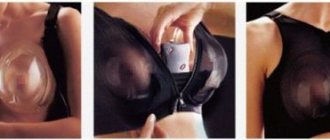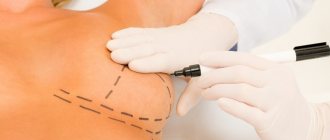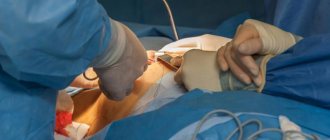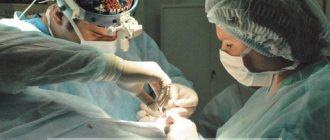Reasons for revision mammoplasty
Any medical complications after the initial intervention are reasons why secondary mammoplasty should be performed immediately. These include:
- Capsular contracture. During healing around the surface of the prosthesis, the surrounding tissue transforms into fibrous tissue. For this reason, asymmetry is possible. The causes of the occurrence have not been studied, so there are always risks - 28% of repeat plastic surgery are caused by this particular complication. Scarring is most likely to occur around smooth surfaces.
- Displacement of the prosthesis. Possible if rehabilitation rules are not followed - when sleeping on the stomach or side, when lifting heavy objects.
- Rupture of the implant shell (the patient must remember that the gel located inside the implant shell will not leak out or go anywhere, since the gel has “shape memory”) Occurs due to mechanical damage, for example, during accidents or strong impacts. Therefore, during correction, the filler is replaced with silicone, which does not penetrate into the surrounding tissue even with cracks. Diagnosis of a silicone crack is only possible using a cross-section of an MRI.
- Skin rupture due to incorrectly selected endoprosthesis size;
- Ill-formed pocket. As a rule, a loose installation plane provokes displacement of the implant to the side or up or down, while a too narrow one leads to capsular contracture.
- Synmastia. Occurs when the chest is concave or when using endoprostheses with a wide base.
- Feeling the edge of the shell (contouring, ripples);
- Tissue necrosis, purulent infections, inflammatory processes, bleeding;
- Deformation of the implant as a result of poor quality material;
- Detection of developing oncology;
- Calcification – compaction as a result of salt deposition;
- Double fold.
What's happened
Secondary mammoplasty is a surgical intervention, the main task of which is to correct the mammary glands after obtaining a negative effect. Also, such manipulation is indicated if there is a need to replace implants or if certain complications begin to develop.
Secondary mammoplasty is usually performed to correct the unsuccessful result of the first operation or when complications develop.
Usually the patient is not satisfied with the resulting size, asymmetry, contouring of the implant and other problems.
It is worth remembering that the risks of repeated intervention are always increased; a new surgeon may not know which techniques were used the first time.
Therefore, it is necessary to decide on repeated surgical treatment after carefully weighing all factors.
In most situations, performing a secondary operation is possible. However, every patient should understand that from the point of view of technique, this is a more complex procedure for breast correction after augmentation. In addition, the likelihood of developing consequences increases, which is explained by several reasons.
First of all, the surgeon will have to work with adhesions that form in soft tissues and make them less pliable. As a result, the surgical process becomes more complicated.
In addition, if mammoplasty was initially performed by another doctor, then the second time it is difficult for the specialist to determine the scheme used previously.
For a more successful outcome, it is also important to choose the right surgeon.
Indications
Any other indications relate to aesthetic dissatisfaction with the shape of the bust:
- Increase/decrease bust size;
- Complete removal of the endoprosthesis;
- Shape correction after losing or gaining weight;
- Asymmetry;
- Changes due to age or pregnancy;
- Prolapse of the mammary glands. Ptosis occurs when breasts increase by 3-4 sizes. The pressure on soft tissues increases, blood circulation slows down, so the glands gradually atrophy. In this case, correction using laser and tightening is necessary.
- The appearance of folds and ripples in the skin.
- Endoprosthesis expiration date. Applies to products with a shelf life of up to 15 years. Now they manufacture products with a lifetime warranty.
Preoperative preparation
The preparatory stage begins with a consultation with a surgeon. The doctor evaluates the mammary glands, their shape, ptosis, the position of the prostheses, and the condition of the skin. Access options are being discussed. As a rule, repeat mammoplasty is performed through the same approaches as the primary one. Exception: axillary access.
The doctor warns about the likelihood of complications and directs you to undergo a standard package of tests before surgery:
- General blood and urine analysis;
- Blood examinations for biochemistry and coagulation;
- Infection testing;
- Ultrasound and MRI of the mammary glands;
- Fluorography;
- Mammography;
- ECG.
Contraindications
Secondary breast plastic surgery is no different from primary breast surgery, therefore the contraindications are the same. The procedure is not recommended if the patient has the following health problems:
- cardiovascular diseases;
- blood clotting disorder;
- diabetes mellitus in a serious form;
- oncological diseases;
- During pregnancy and breastfeeding;
- renal and liver failure.
Typically, surgery is contraindicated if there is inflammation in the chest. If inflammation arose as a pathology as a result of the first plastic surgery, then the second operation is performed to eliminate the inflammation.
Technology
The method of execution depends on the desired result, the degree of deformation and prolapse of the glands:
- If the patient wants to change the volume to a smaller/larger direction, then the previous implants are first removed, then the formed pocket is corrected (it is sutured when the size decreases). After which new endoprostheses are installed. The operation ends with tissue tightening and correction of the nipple-areolar complex.
- When contouring plastic is accompanied by lipofilling.
- In plastic surgery due to capsular contracture, the implant is removed along with fibrous tissue, then the pocket is cleaned and a new textured endoprosthesis is installed. Also, the capsule can be partially removed, depending on the degree of damage.
- When treating symmastia, pockets are cleaned and old implants are removed. Then you need to wait 10-12 weeks to apply sutures to close the wide area.
For repeat mammoplasty for aesthetic purposes or to eliminate capsular contracture, incisions are made along the scar lines.
However, if the operation is performed to correct any deficiencies, then new incisions are possible:
- When eliminating slight ptosis, raising the nipples and areola, areolar access is necessary;
- For a full breast lift, the incision is made vertically from the lower edge of the areola to the fold under the gland;
- Folds and skin ripples are eliminated with a horizontal incision along the semicircle below the areola. This way, nipple sensitivity is maintained.
When suturing, cosmetic stitches are used, which after healing are almost invisible.
The process of removing the old implant takes no more than 20 minutes, and the operation itself lasts longer than the initial one, approximately 2-4 hours.
Removing gel from breasts
Polyacrylamide gel migrates in tissues, changes them, causes inflammation, discomfort, and pain.
The only way out is to remove the gel. In the early 90s, polyacrylamide gel began to be widely used to enlarge and correct various parts of the face and body, in particular the breasts. The minimally invasive nature of the method attracted women, but over time, patients began to complain about side effects.
Complications after breast augmentation with gel are so terrible and long-lasting that women still turn to plastic surgeons at our clinic asking for repeat mammoplasty to remove the gel.
Sarvar Bakirkhanov comments:
“I urge all patients who still have this gel in their body: remove it as soon as possible, even if it does not bother you. This “time bomb” will make itself felt sooner or later.”
Rehabilitation
The secondary operation is much more traumatic, so the recovery process takes longer (but everything is individual). Rehabilitation when forming a new plane or eliminating FCC takes about 4-5 months.
Rehabilitation recommendations are identical to the recovery rules for primary plastic surgery: visiting saunas, steam baths, and hot baths is prohibited; physical activity must be limited until the tissues have completely healed.
The most important thing in rehabilitation is to wear compression garments, since in the first months physiological fluid can get into an unsealed pocket.
Features of repeated surgery
- If the installation plane is severely deformed or there is repeated scarring, then the pocket is changed. For example, the implant was installed on the surface of the muscle, and during corrective plastic surgery it is placed under the muscle.
- It would be most correct if the secondary operation is performed by the same doctor as the primary one. After all, the surgeon is familiar with your body and knows the technique for placing the previous prosthesis.
- An inframammary incision (submammary approach) is often used. This is explained by the fact that the view is more extensive, the surgeon most accurately removes scar tissue. It's much easier to create or modify a pocket.
- To minimize the risk of ptosis, in patients with thin skin, the implant is placed under the large muscle. The mammary glands themselves are strengthened with fillers.
If capsular contracture is accompanied by rupture of the integumentary tissue, re-plasty involves installing a smaller volume of implant. In addition, only textured models will be used (Micropolyurethane surface)
- If ptosis progresses, it is necessary to combine a breast lift with endoprosthetics.
- When planning to lose extra pounds by more than 7 kg or more, the operation should be postponed until the weight stabilizes.
- Removal of the capsule (partial or complete) when replacing an endoprosthesis is mandatory. Otherwise, particles of old fibrous tissue will grow in, and you will get a feeling of hard and rough breasts.
Complications and side effects
The risk of complications after re-plasty increases. The fact is that the elasticity of soft tissues decreases due to secondary incisions. The sutures tighten more slowly, and the number of hardened adhesions increases. Also, more microvessels are damaged the second time, resulting in slower tissue regeneration and repair.
When re-endoprosthetics of the mammary glands is possible:
- The appearance of pain in the correction area. They are felt after leaving the anesthesia and can last up to three days. During this period, the doctor recommends taking painkillers;
- Swelling of tissues. Due to this, pain can be caused, because. the glands are tense. Basically, swelling occurs after lifting or replacing implants. In this case, analgesics are also prescribed;
- Bleeding from the nipples. The probability of developing such a side effect is 48%. Hemorrhages develop as a result of increased fragility of the walls of blood vessels;
- Formation of hematomas. They can grow in the operated area. This indicates blood infiltration. Hematomas resolve on their own if the area of growth does not increase and pain does not appear;
- Seams coming apart. As a result of repeated mammoplasty, the skin becomes thinner, and bruising may appear in the first days of recovery. The complication is aggravated by ignoring the rules of rehabilitation - incorrect wearing of compression garments and early physical activity;
- Tissue infection. The risk of occurrence is 1%. Occurs when immunity decreases or viral infections in the body are undetected before surgery. The doctor prescribes antibacterial therapy;
- Decreased or loss of sensitivity. Develops 3-4 weeks after the procedure. Associated with damage to the nerve trunk;
- Breast asymmetry and tissue deformation.
Author: Mamedov Rusif Bezhanovich Plastic surgeon, Candidate of Medical Sciences Received the “Grace” Award in the nomination “Best Plastic Surgeon for Facial Plastic Surgery”. Practices a unique endoscopic lifting technique, which is performed in the upper and middle zone of the face, as well as in its lower part.
Question answer
After surgery, the breasts appear to be asymmetrical.
What to do in this situation? The final result should be assessed after at least 6-7 months. Before this, the process of “living” of the implant in the pocket occurs. If the discrepancy in symmetry increases in the future, it is necessary to consult a surgeon.
I'm not happy with the result. After how long can the operation be repeated?
Corrective mammoplasty is possible no earlier than after 6-7 months. The exception is any urgent medical condition.
Is it necessary to undergo breast replacement after 10-15 years?
No, unless there are medical indications, there are no abnormalities on the MRI image. In addition, materials with a lifetime guarantee are now used, so there is no need for this. However, from an aesthetic point of view, correction may be required due to the development of ptosis.
A year after I had my new bust done, it became firmer. What to do?
After six months, if the mammary glands become harder and there is a feeling of compression, then it is necessary to perform a mammography (MRI) to identify fibrocapsular contracture. If the developing process is confirmed, repeat mammoplasty should be performed immediately, otherwise the capsule will shrink more and FCC will worsen with tissue necrosis.
Why should you do it?
Planned re-intervention in the mammary glands is possible in the following situations.
Large implant size
It happens that after surgical manipulation a woman receives larger breasts than she originally expected. To remove such a disproportion, the patient resorts to endoprosthetics. It must be remembered that if the surgeon is highly qualified, he will never place implants whose size will not be in harmony with the body.
Desire to make breasts even bigger
A woman can also seek secondary surgery if she receives breasts that are smaller than she wanted.
Displacement of the endoprosthesis
Migration of the endoprosthesis can occur due to poor quality of surgical intervention. In such situations, specialists replace the material with another.
Loss of form
Often patients repeatedly seek help from a surgeon when they lose their shape. If sagging is noted, then lifting and augmentation are performed simultaneously.
In addition to aesthetic reasons, there are also emergency cases when breast surgery is a necessary measure.
Skin rupture
In most cases, such a complication occurs in situations where an oversized prosthesis is installed. Re-endoprosthetics is required to correct the problem.
Capsular contracture
This is a pathological process in which a dense scar membrane begins to form around the implant. As a result, a lump appears in the breast, due to which the woman may experience severe pain.
Why can our articles be trusted?
We make health information clear, accessible and relevant.
- All articles are checked by practicing doctors.
- We take scientific literature and the latest research as a basis.
- We publish detailed articles that answer all questions.
Also, against the background of this complication, the mammary glands may become deformed. Capsular contracture leads to the formation of seromas, the development of purulent-inflammatory processes and the opening of bleeding.
Violation of the structure of the prosthesis
This is possible if low-quality implants were used for breast augmentation. Salt materials pose the greatest danger, since when they are damaged, contents begin to leak into the gland.
To minimize risks, it is recommended to insert endoprostheses with gel filling. However, repeat mammoplasty may be required in both cases.
Implant loss
This situation may arise if the suture does not heal for a long time. In addition, excessive skin tension is often the underlying reason for surgical intervention.
Rejection
This complication is rare and requires complete removal of the implants from the gland. Subsequently, to enlarge the bust, the specialist will recommend using alternative methods, for example, lipofilling.










